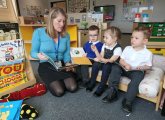Anna Craft discusses how Possibility Thinking can be harnessed to design learning opportunities in a digital world…
Evie is five. She holds out her puppet proudly, saying “We can design things and we make things… We were designing a drink… Now we are designing a puppet”. Asked how she feels about her puppet, this is how our conversation goes:
Evie: “Happy…. very glad with yourself.”
Anna: “Why?”
Evie: “Because you’ve got loads of ideas… you know what to do… Sometimes you get a bit happy and then sometimes you get a bit nervous… in case you don’t get the right things on the right tracks.”
Evie reveals through talk how comfortable she is with ‘Possibility Thinking’. She’s shifting what is, to what might be, by asking what if? Max and Jordan do it at 16 months, using the watering can to repeatedly drench the path. They too are exploring what if? And it’s what four-year-old Ali was doing the morning I met Evie: “At playtime I made up my own game… I whizz round in circles and then fall over.”
Posing questions drives creativity – extending exploration which solves and designs new problems and possibilities. Children do it from birth. Early childhood experiences should give children plenty of opportunities to independently and collaboratively:
● follow their fascinations;
● pose their own questions;
● explore both.
The exploratory play which emerges from these opportunities is ‘Possibility Thinking’: transforming what is to what might be.
Research shows posing questions or asking “What if?” is only part of Possibility Thinking, however. Just as important is acting as if, which is what two-and-a-half-year-old Enya, and her four-and-a-half-year-old brother, Hasif, do, inventing their ‘Kitty’ game. Enya declares she is ‘owner’; Hasif becomes her kitten. Playing in role, the game uncurls and stretches across six years, until Enya is eight and Hasif 10.
As if thinking may also be momentary; it is for Wali, crawling through a climbing frame as if she’s being pursued, before jumping off, as if flying like a bird. Acting as if, opens up new ways of understanding and engaging. Children need opportunities to:
● initiate, take on and explore roles;
● use space and resources in ways that support these;
● sustain as if play over time.
What comes to mind when you imagine young children being creative? Do you imagine paints and crayons, modelling dough and mud, songs with actions, role plays, dance and movement? Do you conjure up the ‘creative corner’? Or do you think about how opportunities for Possibility Thinking permeate your practice? Music, art, dance and drama are all vehicles for Possibility Thinking, but stripped right back, designing what might be from what is underpins all that we do, in and beyond the arts.
Skilfully enabling children’s Possibility Thinking means maximising curiosity and enabling choices. This is empowering, as six-year-old Max explains: “Choosing… is like a playtime… If you’re drawing you can go kind of mad, you can go like crazy, you can do whatever you like, you can make your mad ideas come true.”
Making your mad ideas come true is how as if and what if? thinking translates into the digital play-space. With rapidly-increasing access to digital media, children’s worlds are expanding. They can play, connect and make their own content, in new ways.
Many young children connect through offline games with friends, playing together on the same console. However, with gaming devices such as the Nintendo Wii and Nintendo DSi offering online play, very young children very quickly connect with others. These online spaces enable children to do four Ps:
Be Plural – connecting with people and digital playmates in multiple play/social places, experimenting with their own online presence.
Be Playful – Digital spaces are co-exploratory; children improvise with imagination. And children and young people can continue to play long after they can credibly go to the local playground to fly off the climbing frame.
Participate – Children access playmates, real and virtual. They become author, maker, performer, audience. Digital play-spaces are democratic; all ideas are welcome. Children upload content – images, recordings, messages, animations.
Children explore Possibilities, translating what is to what might be, quickly and easily. An avatar can fly, swim or cook at a click.
Childhood is changing as new technologies supersede the old, and this creates dilemmas. How do we ensure children are safe? How do we ensure balance between actual and virtual play? Work with parents and families to consider these questions. What kinds of digital opportunities do children have at home? What do they enjoy exploring? How do parents feel about what their children can access? What does digital play enable their children to do? What is the balance between children’s active physical play and periods of ‘inactivity’ spent in digital play?
Digital tools help develop fine motor and other operational skills, and enable children to develop knowledge and understanding of the world through problem-solving, creative development and playful behaviour. They contribute to personal, social, emotional development and more.
As childhood changes, so adults need to use Possibility Thinking in considering how to nurture a high-trust culture that recognises children as active, capable producers and consumers, with virtual and actual lives.
We need to move, with children and families, toward better integration of virtual and actual learning. The digital genie won’t go back in the bottle. It’s up to us all to enable exciting, relevant and appropriate learning for young children that acknowledges their experiences. And to do that, we need to harness our own capacity to ask “What if?” and to experiment with acting as if.
Five steps to nurturing Possibility Thinking in your setting…
1. Create inclusive learning environments – where children’s ideas and experiences are highly valued and dialogue is encouraged.
2. Recognise opportunities for what if? and as if thinking.
3. Challenge children to raise big questions, enabling ‘possibility broad’ learning, ensuring tasks extend rather than constrain (independence rather than templates).
4. Employ an active, sensitive pedagogy, valuing children’s activism, making time and space for children to engage, standing back with acute sensitivity to when and how to respond and lead.
5. Value children’s independence and collaboration, encouraging reflection among children and adults.
Professor Anna Craft’s book, Creativity and Education Futures: Learning in a Digital Age (Trentham Books, 2011), looks at the challenges of Possibility Thinking in a digital age.

Keep SLC on top of the agenda
Editors picks

Pretend play – How to harness its learning potential
Editors picks
